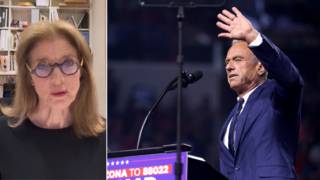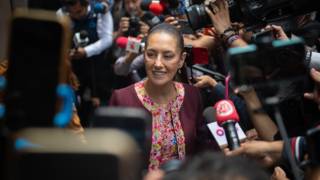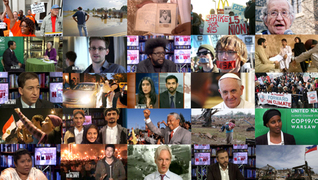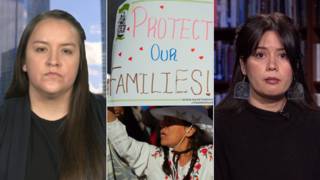
Related
Guests
- Sarah van Geldereditor-in-chief of YES! Magazine, which she co-founded. Her latest piece is “10 Hopeful Things That Happened in 2013 to Get You Inspired for What’s to Come.”
On the last day of 2013, we look back on some of the many signs of hope that emerged on issues ranging from economic equality to LGBT rights to climate justice. With all the bad news that came this year, there were many encouraging displays of a shifting public consciousness and a willingness by ordinary people to mobilize for change. We are joined by Sarah van Gelder, co-founder and editor-in-chief of YES! Magazine, whose latest article is “10 Hopeful Things That Happened in 2013 to Get You Inspired for What’s to Come.”
Transcript
AMY GOODMAN: As 2013 winds down, we’ve compiled a list of the top 20 most viewed interviews this year on our website. Visit democracynow.org and look for a new blog post where you can watch those video highlights.
Well, yes, today is the last day of 2013. Tomorrow, on New Year’s Day, we’ll spend an hour looking back at the year that was. Tens of thousands were killed as Syria descended into one of the worst humanitarian crises in decades. A trove of leaked documents by Edward Snowden revealed a massive U.S.-run surveillance apparatus that spans the entire globe. Countries once again failed to reach a sweeping agreement on climate change as extreme weather caused havoc, including a typhoon that killed over 6,000 people in the Philippines.
But today we’re going to focus on some of the signs of hope that emerged in 2013, on issues from economic equality to LGBT rights to climate justice. With all the bad news that came in 2013, there were many encouraging signs of a shifting public consciousness and a willingness by ordinary people to mobilize for change.
Sarah van Gelder is the co-founder and editor-in-chief of YES! Magazine. She has just written a year-in-review article called “10 Hopeful Things That Happened in 2013 to Get You Inspired for What’s to Come.”
Sarah van Gelder, welcome to Democracy Now! So, what should we be inspired by?
SARAH VAN GELDER: Well, I think we should be inspired by the fact that there are so many people in the United States and all over the world who are working for change, many of which are actually being successful.
AMY GOODMAN: Talk about number one in your article, seeing a surprising new leadership on the climate issue.
SARAH VAN GELDER: Well, I think, ever since Copenhagen, the strategy of the big environmental groups and Democrats in Congress, which was to get some kind of cap and trade, to get some kind of global agreement, I think that has basically come to a standstill. So now the attention and the initiative and the leadership is shifting to the grassroots. There are students who are working on the divestment campaign. They’re succeeding in getting colleges and universities to divest from fossil fuel companies. There’s indigenous folks all over the world, and particularly we saw an uprising in 2012, 2013, of Idle No More. There are state and local governments—
AMY GOODMAN: Actually, Sarah, we want to go to Idle No More. This month, Foreign Policy magazine named the four founders of Idle No More—Jessica Gordon, Sylvia McAdam, Sheelah McLean and Nina Wilson—among its list of the 100 leading global thinkers of 2013. They were commended for demanding that Canada not leave its First Nations behind. One of the movement’s most high-profile supporters is Chief Theresa Spence, who went on a weeks-long hunger strike in a teepee just outside Ottawa’s Parliament at the end of 2012. She warned she would starve herself until she gets a meeting with Prime Minister Harper to discuss respect for historical treaties.
CHIEF THERESA SPENCE: We’re living in the Third World. And this shouldn’t be happening in this country, you know? They’re getting rich by our land. Everybody is using our traditional land except us. And all these mining companies and other forestries and other things that’s been happening in our community, there’s no benefits for us. It’s all going to the government.
AMY GOODMAN: Sarah van Gelder, you interviewed the four women who founded Idle No More in the piece you wrote, “Why Canada’s Indigenous Uprising is About All of Us.” Talk about their work and what’s happened this year since Chief Spence’s hunger strike.
SARAH VAN GELDER: Well, what’s extraordinary is that Prime Minister Harper thought he could sort of push through this major new fossil fuel extraction enterprise across Canada, just rolling over all the First Nations people and everyone else who has concerns about the air and water quality through his legislation, C-45. And he found out that he actually couldn’t do that quite that way. And one of the reasons he couldn’t is because, again, across Canada, First Nations groups formed local versions of Idle No More.
Idle No More is very much of a grassroots effort. These women were not major indigenous leaders. They were not people who were on the front page. They were people who were active in their own communities, but they came together and said, “We cannot acquiesce to this sort of pillage of our lands anymore, and we will be idle no more.” And that inspired people across Canada, and then in the United States and elsewhere around the world. They did flash mob round dances, where they would basically do an occupation of intersections and public spaces. They had the fast that you mentioned. There have been blockades in places where there are efforts to get fracking going. There’s one going on right now in New Brunswick.
So, I think what we’re seeing is that a lot of the initiative now on the climate question is coming down to each local area. We have some of this going on in the Pacific Northwest, as well, where extreme oil and extreme energy is causing all sorts of local damage. I mean, the train wreck in North Dakota is an example of this going on right now also. People are standing up for their rights to have a clean environment where they are, but they’re also aware that this is very much linked to the climate crisis globally.
AMY GOODMAN: Sarah van Gelder, we’re speaking to you in Seattle. In your wrap-up of the hopeful things that happened in 2013, you write about the beginning of an education uprising. We covered parts of these developments in May, when teachers, students and parents in Seattle won their campaign to reject standardized tests in reading and math. Their protest began in January when teachers at Garfield High began a boycott of the test, saying it was wasteful and being used unfairly to assess their performance. I spoke with Jesse Hagopian, a high school history teacher and union rep at Garfield High School, just after their victory.
JESSE HAGOPIAN: We were celebrating the fact that our students will no longer have to sit in front of the dull glow of a computer screen, looking at questions that they were never prepared for because the test was not aligned to the state-mandated curriculum. And we were celebrating because our English-language learners will no longer have to be humiliated by a test that is linguistically and culturally inappropriate for them. Our special ed students will no longer have to take a test where their IEPs, or individual education plans, will no—are not respected.
And, you know, we were celebrating, I think, too, because Washington state ranks number one in the nation in high-stakes testing. And we spend over $100 million a year on these tests. And Garfield High School teachers and teachers around Seattle who have joined the boycott of the MAP test have said that we would rather spend that $100 million on reading coaches and on tutoring programs, things that can actually help elevate our students and get them where we know they need to be.
AMY GOODMAN: Jesse Hagopian, high school history teacher and union representative at Garfield High School. Sarah?
SARAH VAN GELDER: Yeah, we’re actually—our next issue of YES! Magazine is going to be on education, and we’re going to be telling that story from Garfield High School in some depth, partly because it’s an exciting example of something that happened in 2013, but also because we think this is going to be spreading. What we’ve seen around the country is austerity, which cuts back on the budgets of schools, including ones that are really struggling; the whole Race to the Top, which is a successor to No Child Left Behind, which is basically using high-stakes testing to punish schools that are struggling with—especially with students that are coming right out of poverty; the sort of punitive attitude towards teachers or students who are having a hard time—instead of supporting them in succeeding, we’re seeing this kind of punitive approach. And what we’re doing in this next issue of YES! is looking at how—what it will take to actually get these schools to succeed and what it will take to get this movement to spread, so that instead of punishing our schools, we’re supporting them and we’re preparing students for the kind of a world that they’re going to be inheriting, not the kind of world that will just slot them into low-wage jobs.
AMY GOODMAN: The LGBT movement won a historic victory in June when the Supreme Court struck down the Defense of Marriage Act and paved the way for same-sex marriages to resume in California. In a five-to-four decision, the court ruled the 1996 DOMA, the Defense of Marriage Act, signed by President Clinton, was unconstitutional. This means that legally married same-sex couples entitled to claim the same 1,100 federal benefits as heterosexual couples. The lead plaintiff in the case, 84-year-old Edith Windsor, hailed the ruling.
EDITH WINDSOR: I’m honored and humbled and overjoyed to be here today to represent not only the thousands of Americans whose lives—whose lives have been adversely impacted by the Defense of Marriage Act, but those whose hopes and dreams have been constricted by the same discriminatory law. Children born today will grow up in a world without DOMA, and those same children who happen to be gay will be free to love and get married as Thea and I did, but with the same federal benefits, protections and dignity as everyone else.
AMY GOODMAN: That was Edie Windsor. Democracy Now! also spoke about the Supreme Court’s ruling that paved the way for same-sex marriages to resume in California. We interviewed Stuart Gaffney and John Lewis, who were two of the plaintiffs in the California marriage cases that established the freedom to marry before Prop 8 went into effect. This is Stuart Gaffney.
STUART GAFFNEY: You know, this is a sweet moment. Those of us married in 2008, before the passage of Proposition 8—and there are 18,000 couples just like us—we’re all celebrating our five-year anniversaries right now. And what an anniversary gift we have just received from the U.S. Supreme Court to know that now we’re not just the class of 2008, this sort of footnote in the history of marriage equality in this country, but instead we’re the beginning of an era that now continues of the freedom to marry in California, thanks to this decision yesterday. It’s really a happy day not just for the rights of all fair-minded Americans, but also for our friends who have been waiting for as long as five years to finally be able to legally say, “I do.” You showed us the joy from the steps of the U.S. Supreme Court, and I can tell you that in San Francisco City Hall, the joy was that much or even greater as we looked around and saw our friends begin to plan their wedding day.
AMY GOODMAN: That was Stuart Gaffney, and he was sitting next to John Lewis, his partner. Sarah van Gelder, the significance of this?
SARAH VAN GELDER: Well, I think we’ve really hit a tipping point on this issue, Amy. I think, you know, it used to be that a slight majority were opposed to same-sex marriages; now it’s turned, and a slight majority of Americans favor it. We now have about a third of the population of the United States living in states where marriage is allowed. The federal government now, after they refused to defend DOMA at the Supreme Court—and, of course, now that it’s been overturned—the federal government is now making benefits available to same-sex couples. So I think we’ve really hit a turning point. Even the state of Utah, of course, now allows gay marriage.
AMY GOODMAN: And then let’s turn to healthcare. In our coverage of “Obamacare” this year, we also covered how it’s fed interest into single-payer healthcare. In October, I spoke with Dr. Steffie Woolhandler, the primary care physician and co-founder of Physicians for a National Health Program, which has worked with the group Healthcare-NOW! to continue their push for single-payer both at the state level and at the national level.
DR. STEFFIE WOOLHANDLER: Single-payer is also known as expanded and improved Medicare for all, also known as nonprofit national health insurance. It means you would get a card the day you’re born, and you’d keep it your entire life. It would entitle you to medical care, all needed medical care, without co-payments, without deductibles. And because it’s such a simple system, like Social Security, there would be very low administrative expenses. We would save about $400 billion, which would allow us to afford the system. I mean, I just want to remind you that when Medicare was rolled out in 1966, it was rolled out in six months using index cards. So if you have a simple system, you do not have to have all this expense and all this complexity and work.
AMY GOODMAN: What do you mean, “index cards”?
DR. STEFFIE WOOLHANDLER: They didn’t have computers back in 1966, OK? So they expanded—went from zero to over 20 million people enrolled in Medicare in a period of six months. And because it was a simple system, based on the Social Security records, it was a tax-based system, you didn’t have hundreds of people programming the state of Oregon, thousands of different plans, tons of different co-payments, deductibles and restrictions—one single-payer plan, which is what we need for all Americans to give the Americans really the choice they want, which is not the choice between insurance company A or insurance company B. They want the choice of any doctor or hospital, like you get with traditional Medicare.
AMY GOODMAN: That’s Dr. Steffie Woolhandler, primary care physician, co-founder of Physicians for a National Health Program. Sarah van Gelder, you’re editor-in-chief of YES! Magazine, wrote this piece, “10 Hopeful Things That Happened in 2013.” How do you get from “Obamacare” to single-payer? So many people feel that what happened this year was so—well, somewhat catastrophic on many different levels.
SARAH VAN GELDER: Well, I’m not sure if we will right away, but I can tell you that in the state of Vermont they’re working on that, and that’s how Canada got single-payer healthcare. It started in one province, in the province of Saskatchewan, and it was such a success that all the other provinces wanted it. And even though the party that had put it into place in Saskatchewan only won an election long enough to put it into place and then were voted out of office, the conservatives and the other parties were never able to take it apart, because it’s been so successful. So, in the state of Vermont, they’re working on a single-payer healthcare system statewide right now. Whether or not they can pull it off, as just one state and a fairly small state, has yet to be seen, but they believe, just as the doctor was speaking of, that there’s so much savings to be gained by a far more efficient system of single-payer, without all the profits and all the bureaucracy that go along with having all these competing for-profit insurance companies. They believe they can get a better system, even just at one state.
AMY GOODMAN: And finally, Sarah van Gelder, we only have a few seconds, but it’s
hard to put Syria on the list of something hopeful that happened, but you managed to.
SARAH VAN GELDER: Well, I did, because I believe—back in the summer, I think many of us believed that we were going to war in Syria, and it was going to become yet another quagmire like Iraq and Afghanistan. And somehow, the combination of people power, perhaps some wisdom from the Obama administration—I think it was the American people rising up and just saying, “We’ve had enough.” But somehow diplomacy won out, international law won out, and instead of the U.S. getting further involved and further making things even worse for the Syrian people, we’re now working with the international community on getting rid of those chemical weapons.
AMY GOODMAN: Well, Sarah van Gelder, I want to thank you very much for joining us, editor-in-chief of YES! Magazine. Her latest piece, “10 Hopeful Things That Happened in 2013 to Get You Inspired for What’s to Come.” We’ll link to it at democracynow.org.
Tune in on New Year’s Day, on Wednesday, for our special year in review that looks back at 2013. You can also visit our website to see the top 20 most viewed interviews this year at democracynow.org.












Media Options